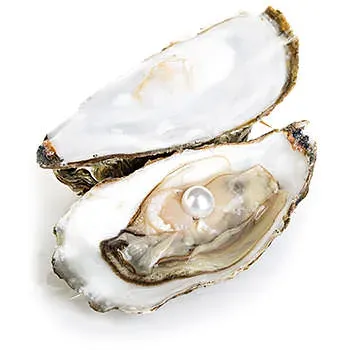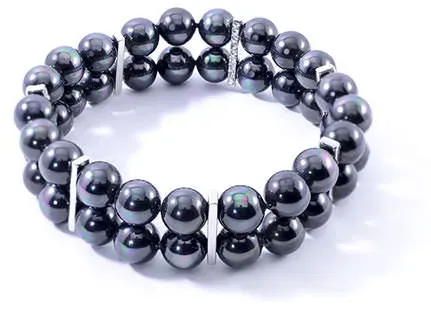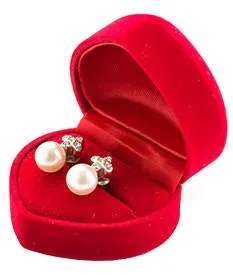 People of many nations have treasured pearls for thousands of years. The Romans valued pearls so highly, they created a law forbidding anyone except people of high rank, from wearing them. European explorers in the New World found many tribes of Indians in North and South America wearing pearl adornments. In 1579, King Philip II of Spain received a pearl from his representatives in Panama that weighed 1250 grains. Julius Caesar was also a great admirer of pearls and gave one as a gift that was worth $150,000. Pearl is one gem that does not come from the earth. It is a gem that forms in mollusks (clams, oysters, mussels and such), which can be found in fresh and salt water. Pearls are formed when some sort of small foreign body, such as a grain of sand, or a small parasite, gets inside the mollusk and layers of pearly material form around it as a natural defense against these irritants. In a true pearl (not cultured) the layers build up like the layers of an onion, in concentric circles. Light reflecting from these overlapping layers creates a characteristic iridescent luster, also known as the orient of pearl. The older the pearl is, the more numerous the layers are, and the larger the pearl is.
People of many nations have treasured pearls for thousands of years. The Romans valued pearls so highly, they created a law forbidding anyone except people of high rank, from wearing them. European explorers in the New World found many tribes of Indians in North and South America wearing pearl adornments. In 1579, King Philip II of Spain received a pearl from his representatives in Panama that weighed 1250 grains. Julius Caesar was also a great admirer of pearls and gave one as a gift that was worth $150,000. Pearl is one gem that does not come from the earth. It is a gem that forms in mollusks (clams, oysters, mussels and such), which can be found in fresh and salt water. Pearls are formed when some sort of small foreign body, such as a grain of sand, or a small parasite, gets inside the mollusk and layers of pearly material form around it as a natural defense against these irritants. In a true pearl (not cultured) the layers build up like the layers of an onion, in concentric circles. Light reflecting from these overlapping layers creates a characteristic iridescent luster, also known as the orient of pearl. The older the pearl is, the more numerous the layers are, and the larger the pearl is.
 Real pearls are becoming more and more scarce as the waters where the pearl-producers live are becoming increasingly contaminated and many mollusk-producing areas have been partially exhausted by being overworked. Pearls are not measured by carat; their weight is given in grains. One grain of pearl is equal to one-quarter carat of gem stone weight, so it takes 4 grains of pearl to equal 1 carat in weight of other gemstones. The color of genuine pearls ranges from white to pink, blue, brown, gray and black, depending on the type of mollusk and the water in which they are found. Experts judge pearls by size, shape, color, luster, and degree of perfection. Pearls rate a 2.5-4.5 on the hardness scale.
Real pearls are becoming more and more scarce as the waters where the pearl-producers live are becoming increasingly contaminated and many mollusk-producing areas have been partially exhausted by being overworked. Pearls are not measured by carat; their weight is given in grains. One grain of pearl is equal to one-quarter carat of gem stone weight, so it takes 4 grains of pearl to equal 1 carat in weight of other gemstones. The color of genuine pearls ranges from white to pink, blue, brown, gray and black, depending on the type of mollusk and the water in which they are found. Experts judge pearls by size, shape, color, luster, and degree of perfection. Pearls rate a 2.5-4.5 on the hardness scale.
 It has been said that a dream of pearl means that you will be seeing faithful friends. In ancient stories, pearl is associated with faithfulness, friends, loyalty, modesty and purity. Pearl is one of the nine sacred gems listed in Sanskrit, Chinese, Arabic, and Burmese. Pearls are found in Sri Lanka, the Philippines, the Gulf of California and the Caribbean. Fresh and saltwater pearls are cultivated in China and Japan. Freshwater pearls also occur in the rivers of Scotland, Ireland, France, Austria, and Germany and in the US, in Mississippi. The Persian Gulf, the Gulf of Manaar (Indian Ocean) and the Red Sea have all been producing pearls for thousands of years. The coasts of Polynesia and Australia produce mainly cultured pearls.
It has been said that a dream of pearl means that you will be seeing faithful friends. In ancient stories, pearl is associated with faithfulness, friends, loyalty, modesty and purity. Pearl is one of the nine sacred gems listed in Sanskrit, Chinese, Arabic, and Burmese. Pearls are found in Sri Lanka, the Philippines, the Gulf of California and the Caribbean. Fresh and saltwater pearls are cultivated in China and Japan. Freshwater pearls also occur in the rivers of Scotland, Ireland, France, Austria, and Germany and in the US, in Mississippi. The Persian Gulf, the Gulf of Manaar (Indian Ocean) and the Red Sea have all been producing pearls for thousands of years. The coasts of Polynesia and Australia produce mainly cultured pearls.
 If you want your pearl to last a lifetime, it is important not to expose it to sunlight, humidity, dryness, wide temperature variations, or acids which can all dull a pearl's luster. Natural pearls retain their qualities better than cultured pearls. Pearls are also relatively soft and can be marked by scratches and crushed by pressure. Wearing your pearls often is the best way to care for them as the body's natural oils keep them lustrous. Wipe the pearls with a soft cloth before putting them away.
If you want your pearl to last a lifetime, it is important not to expose it to sunlight, humidity, dryness, wide temperature variations, or acids which can all dull a pearl's luster. Natural pearls retain their qualities better than cultured pearls. Pearls are also relatively soft and can be marked by scratches and crushed by pressure. Wearing your pearls often is the best way to care for them as the body's natural oils keep them lustrous. Wipe the pearls with a soft cloth before putting them away.